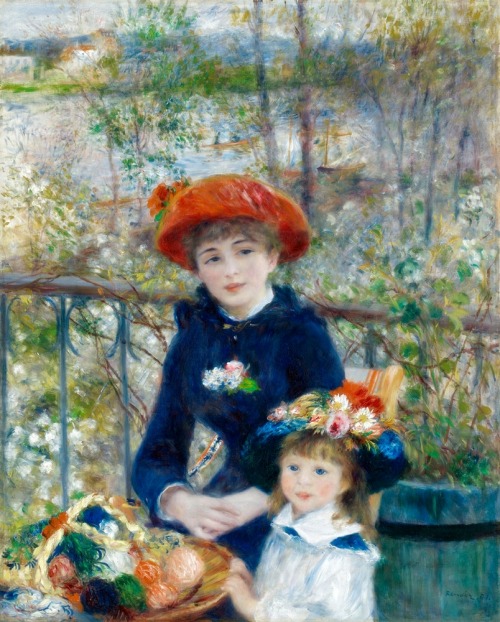#on the terrace
MWW Artwork of the Day (4/15/16)
Pierre-Auguste Renoir (French, 1841-1919)
Two Sisters (On the Terrace)(1881)
Oil on canvas, 100.5 x 81 cm.
The Art Institute of Chicago (Mr. & Mrs. Lewis Larned Coburn Memorial Collection)
“Oh what a joy to indulge in the exquisite ecstacy of painting…to me, a painting must be an agreeable, joyful, pretty thing – yes, pretty, really. Why shouldn’t art be pretty? There are enough unpleasant things in the world.” – Pierre-Auguste Renoir
There’s justice in Renoir’s reply to his critics, but his art not merely “pretty,” however much it gravitated towards the comely and pleasant and eschewed the ugly and disturbing. From all accounts possessed of a singularly cheerful temperament, Renoir imbued his scenes with a “joie de vivre” rare in the art of any era. His paintings radiate human warmth, affording their subjects all possible understanding, tolerance, and respect that his son Jean, the great filmmaker, was to do in another medium.
Renoir concluded his fifteen-year exploration of the theme of bourgeois leisure with this superb painting of 1881. The setting is a terrace of the Restaurant Fournaise, an establishment in the village of Chatou, on the Seine, where Renoir had previously executed “The Rowers’ Lunch,” among other works.
A celebration of the beauty of spring and the promise of youth, “Two Sisters (On the Terrace)” is a technical and compositional tour de force, a virtuoso display of vibrant color and variegated brushwork. The almost life-sized figures (who were not sisters, as indicated by the work’s original title, but unrelated models) occupy a shallow space in front of a terrace railing; behind them quivers a lively, leafy landscape that brings their sharply delineated forms into vivid focus. The two girls’ faces are extraordinarily refined —- revealing Renoir’s new emphasis on draftsmanship —- and their porcelain complexions are uncompromised by reflections or shadows. The young child’s irises are an almost startlingly clear, translucent blue, suggestive of the artist’s desire to help us see the world afresh, through innocent eyes.
As always Renoir transformed what he saw, infusing nature with the artifice necessary to create harmony. For example the foliage behind the figures cannot rival the artificial flowers that adorn the little girl’s hat. The balls of yarn in the basket, somewhat out of context in this outdoor setting, also refer to the artist’s palette and his skill in deploying it. Shown in 1882 at the seventh Impressionist exhibition, “Two Sisters” signaled Renoir’s impending departure from Impressionism’s preoccupation with rendering transient effects of light by means of flickering brushwork, while summarizing his dedication to the subjects and themes he had presented so buoyantly.
(adapted from several sources)
Renoir’s work is the subject of this MWW exhibit/gallery:
* Renoir & The Joy of Painting
Post link
On the terrace by Pierre-Auguste Renoir, 1881.
Sur la Terrasse de Pierre-Auguste Renoir, 1881.
Auf der Terrasse von Pierre-Auguste Renoir, 1881.
Post link


